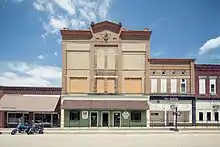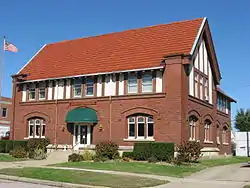Linton, Indiana
Linton is a city in Stockton Township, Greene County, Indiana, United States. The population was 5,413 at the 2010 census. A coal mining city, it is located southeast of Terre Haute. The current mayor is John Wilkes.
Linton, Indiana | |
|---|---|
 "You'll Like Linton" | |
 Location of Linton in Greene County, Indiana. | |
| Coordinates: 39°2′11″N 87°9′56″W | |
| Country | United States |
| State | Indiana |
| County | Greene |
| Township | Stockton |
| Government | |
| • Mayor | John Wilkes (D) |
| Area | |
| • Total | 3.20 sq mi (8.29 km2) |
| • Land | 3.20 sq mi (8.29 km2) |
| • Water | 0.00 sq mi (0.00 km2) |
| Elevation | 531 ft (162 m) |
| Population | |
| • Total | 5,413 |
| • Estimate (2019)[3] | 5,204 |
| • Density | 1,625.74/sq mi (627.73/km2) |
| Time zone | UTC-5 (EST) |
| • Summer (DST) | UTC-4 (EDT) |
| ZIP code | 47441 |
| Area code(s) | 812 |
| FIPS code | 18-44190[4] |
| GNIS feature ID | 0437969[5] |
| Website | www |
Linton is part of the Bloomington, Indiana metropolitan area.
History
Linton was essentially founded around the entrepreneuring of John W. Wines, who first sold goods in the Linton area, briefly in 1831. Although he would later relocate to Fairplay, Indiana, he returned and opened a general store in Linton in 1837. He would later build a small horse mill as well as a tannery. The city itself was officially chartered and named in June 1850, laid out by Hannah E. Osborn and Isaac V. Coddington. In the late 19th century, small underground coal mines began to appear near and almost inside the city and the population expanded rapidly. At the turn of the 20th century, the population was larger than it is today. At one point in the 1920s, there were at least 35 drinking establishments and an equal number of churches.
In 1896, Linton drove 300 African American strikebreakers from town and became a sundown town, prohibiting African Americans from living there.[6] In 1903, union miners drove black waiters from town, and the ban expanded to all of Greene County. Violence against African Americans continued into the 1940s. Historian James W. Loewen cites Linton as an example of a town where strikebreakers were used as pretext for more general discriminatory practices.[7]
In the 1920s, small surface mines began to predominate, and their small, unreclaimed hills and strip-pit lakes still surround the city. The lakes have provided a regular, if limited, amount of fishing tourism for decades. Signs of the underground mines remain as well, including tipples on private land and sinkholes that appear regularly on private property, roads and even within the city limits. By the 1940s, the underground mines were gone and the small surface mines had moved on or been consumed by large corporations such as Peabody Coal Company. These mines were the primary employers well into the 1980s.
In 1952, General Electric built a factory on the southeast side of the city. This factory employed several hundred until the mid-1980s, when GE phased out most of their small motors production in the U.S. The factory building remained empty due to Environmental Protection Agency regulations until GE tore it down beginning in 2014. The company plans to sell the land directly to buyers rather than to the city.
On April 29, 1963, an F3 tornado struck Hoosier, north of Linton.[8] It was the strongest tornado ever recorded in Greene County.[9]
The Linton Commercial Historic District and Linton Public Library are listed on the National Register of Historic Places.[10]
Geography
According to the 2010 census, Linton has a total area of 3.02 square miles (7.82 km2), all land.[11]
Demographics
| Historical population | |||
|---|---|---|---|
| Census | Pop. | %± | |
| 1890 | 958 | — | |
| 1900 | 3,071 | 220.6% | |
| 1910 | 5,906 | 92.3% | |
| 1920 | 5,856 | −0.8% | |
| 1930 | 5,085 | −13.2% | |
| 1940 | 6,263 | 23.2% | |
| 1950 | 5,973 | −4.6% | |
| 1960 | 5,736 | −4.0% | |
| 1970 | 5,450 | −5.0% | |
| 1980 | 6,315 | 15.9% | |
| 1990 | 5,814 | −7.9% | |
| 2000 | 5,774 | −0.7% | |
| 2010 | 5,413 | −6.3% | |
| 2019 (est.) | 5,204 | [3] | −3.9% |
| U.S. Decennial Census[12] | |||

2010 census
As of the census[2] of 2010, there were 5,413 people, 2,325 households, and 1,443 families residing in the city. The population density was 1,792.4 inhabitants per square mile (692.0/km2). There were 2,660 housing units at an average density of 880.8 per square mile (340.1/km2). The racial makeup of the city was 97.7% White, 0.1% African American, 0.3% Native American, 0.4% Asian, 0.3% from other races, and 1.2% from two or more races. Hispanic or Latino of any race were 1.2% of the population.
There were 2,325 households, of which 29.6% had children under the age of 18 living with them, 44.0% were married couples living together, 12.5% had a female householder with no husband present, 5.6% had a male householder with no wife present, and 37.9% were non-families. 33.8% of all households were made up of individuals, and 16.7% had someone living alone who was 65 years of age or older. The average household size was 2.30 and the average family size was 2.88.
The median age in the city was 39.8 years. 23.4% of residents were under the age of 18; 8.4% were between the ages of 18 and 24; 23.9% were from 25 to 44; 25.1% were from 45 to 64; and 19.2% were 65 years of age or older. The gender makeup of the city was 47.7% male and 52.3% female.
2000 census
As of the census[4] of 2000, there were 5,774 people, 2,450 households, and 1,526 families residing in the city. The population density was 1,949.7 people per square mile (753.2/km2). There were 2,792 housing units at an average density of 942.8 per square mile (364.2/km2). The racial makeup of the city was 98.30% White, 0.09% African American, 0.24% Native American, 0.24% Asian, 0.02% Pacific Islander, 0.24% from other races, and 0.87% from two or more races. Hispanic or Latino of any race were 1.25% of the population.
There were 2,450 households, out of which 28.1% had children under the age of 18 living with them, 48.7% were married couples living together, 10.0% had a female householder with no husband present, and 37.7% were non-families. 34.5% of all households were made up of individuals, and 18.6% had someone living alone who was 65 years of age or older. The average household size was 2.26 and the average family size was 2.87.
In the city, the population was spread out, with 22.7% under the age of 18, 7.7% from 18 to 24, 25.3% from 25 to 44, 22.1% from 45 to 64, and 22.3% who were 65 years of age or older. The median age was 41 years. For every 100 females, there were 87.0 males. For every 100 females age 18 and over, there were 82.3 males.
The median income for a household in the city was $26,477, and the median income for a family was $36,138. Males had a median income of $32,213 versus $17,304 for females. The per capita income for the city was $15,554. About 8.2% of families and 12.3% of the population were below the poverty line, including 16.5% of those under age 18 and 12.8% of those age 65 or over.
Arts and culture
Linton Music Festival
The tagline for the Linton Music Festival is "Mayberry meets Woodstock." In 2010, over 12,000 people attended. The festival prides itself in being a free event that offers entertainment for all ages and musical tastes. The festival operates as a non-profit entity that strives to promote the musical arts, economic development, and tourism. It is funded in part by grants from the Indiana Arts Commission and corporate sponsors (DIRECTV, Linton Family Pharmacy, and Node 1 Technology, among others. The Linton Music Festival (LMF) is held annually on the Friday, Saturday, and Sunday prior to Labor Day.
Carnegie Heritage and Arts Center of Greene County

The Carnegie Heritage and Arts Center of Greene County is responsible for preserving and maintaining the historic 1908 Margaret Cooper Public Library building (a Carnegie library), which also houses the city's Phil Harris and Alice Faye memorabilia collection.
Freedom Festival
Linton has been celebrating Independence Day since 1905. Events include the largest Independence Day parade in Indiana-bringing over 40,000 people to this city,[13] a week-long visit from a traveling carnival, local music and entertainment, and fireworks on the Fourth of July.
Marsh Madness
This festival, beginning in 2010,[14] celebrates the wildlife contained in the Goose Pond Fish and Wildlife Area. Goose Pond is a wetlands reclamation project south of the city, which has had some success at restoring marginal farmland to its natural condition. The goal is to encourage hunting, fishing and naturalist excursions.
Notable people
- Chuck Bennett, football player and coach.
- Gene Porter Bridwell, seventh Director of the NASA Marshall Space Flight Center.
- David Butler, first Governor of Nebraska.
- Phil Harris, musician, actor, and comedian.
- Dorothy Mengering, mother of David Letterman.
- Elmer Oliphant, football player.[15]
- Spencer Pope, football player.
In popular culture
Linton is one of the teams that plays against Hickory High in the motion picture Hoosiers.
References
- "2019 U.S. Gazetteer Files". United States Census Bureau. Retrieved July 16, 2020.
- "U.S. Census website". United States Census Bureau. Retrieved 2012-12-11.
- "Population and Housing Unit Estimates". United States Census Bureau. May 24, 2020. Retrieved May 27, 2020.
- "U.S. Census website". United States Census Bureau. Retrieved 2008-01-31.
- "US Board on Geographic Names". United States Geological Survey. 2007-10-25. Retrieved 2008-01-31.
- "One Place on Earth too Hot for a Negro". The Richmond Climax. Richmond, Kentucky. August 5, 1903. p. 2 – via Chronicling America.
At Linton, Ind., in 1896, a coal company imported 300 negroes to take the places of strikers in one of the mines there. The negroes organized a company and drilled with rifles on the streets. One of them shot a white boy and the entire white population, aroused at midnight by fire bell, raided the negro quarters and drove every one of them from the city. Several of them were shot. Since that time not a negro has been allowed to live in the town. On July 6, Alex. Sanderson, a Terre Haute caterer, was employed to serve the banquet at the institution of a new lodge of the Elks. He took his cook and waiters with him and while the lodge work in the hall was going on several hundred miners assembled in the street and threatened to dynamite the hall unless the negroes were sent out of town. They were hurried into a cab and driven to Jasonville, where they were put on the train for Terre Haute. Six policemen hung on the carriage and beat back the crowd while the negroes were driven out of town.
- Loewen, James W. (2018). Sundown Towns: A Hidden Dimension of American Racism. New York City: The New Press. pp. 124–125. ISBN 978-1-62097-454-4 – via Google Books.
- http://www.tornadohistoryproject.com/tornado/19630429.18.19
- http://www.tornadohistoryproject.com/tornado/Indiana/Greene
- "National Register Information System". National Register of Historic Places. National Park Service. July 9, 2010.
- "G001 - Geographic Identifiers - 2010 Census Summary File 1". United States Census Bureau. Archived from the original on 2020-02-13. Retrieved 2015-07-29.
- "Census of Population and Housing". Census.gov. Retrieved June 4, 2015.
- Linton Freedom Festival
- Marsh Madness
- United States Census, 1910
